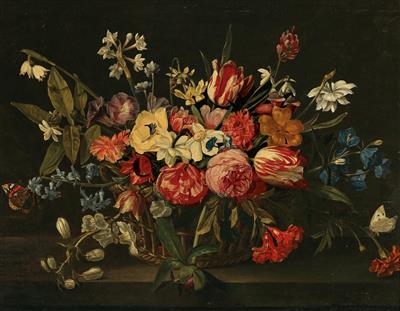Daniel Seghers (Anversa 1590-1661) e Erasmus Quellinus II (Anversa 1607-1678), maniera di
second quarter of the 17th century
Technique: oil painting on canvas Dimensions: 88 x 73.5 cm The painting is attributable to the prolific circle of artists who grew up following Daniel Seghers and also follows the way of painting scrolls and sacred images of one of his major collaborators, Erasmus Quellinus II. Raised as a Protestant, Master Daniel Seghers converted to Catholicism and joined the Jesuit order. He became the supreme creator of a type of still life deeply Catholic: garlands of flowers surrounding stone scrolls or, as in this case, gilded and richly carved altarpieces, which often frame typically contemplative religious scenes. Seghers specialized almost exclusively in paintings based on this concept. This peculiar genre has not only paved the way for its success but has aroused a large following of pupils and epigonic artists. The formula of the flowery garland that surrounds a cartouche in which a religious scene is painted certainly invited collaboration with colleagues specialized in the painting of figurative subjects for the central scene and, consequently, Seghers often collaborated with painters such as Rubens, Hendrick van Balen Thomas Willboirts Bosschaert, Simon de Vos and , in Rome (1625-27), with Nicolas Poussin and Domenichino. However, among the most successful contributions there was that of Erasmus Quellinus II, with whom he created about thirty paintings. In this case the composition is adorned with a festoon of selected flowers, including peonies, roses, san carlini, daffodils and amarillis. The various and sometimes complex shapes are typical of flowers in full glory. The sharply highlighted petals leap forward from the dimly lit background and are eloquently counterbalanced by the brightly lit central scene, thereby achieving a refined simplicity, characteristic of Seghers. The altar, on the other hand, with the image of the Virgin in monochrome, has strong references to the graceful forms and rounded faces of Erasmus. Framed
Daniel Seghers (Anversa 1590-1661) e Erasmus Quellinus II (Anversa 1607-1678), maniera di
second quarter of the 17th century
Technique: oil painting on canvas Dimensions: 88 x 73.5 cm The painting is attributable to the prolific circle of artists who grew up following Daniel Seghers and also follows the way of painting scrolls and sacred images of one of his major collaborators, Erasmus Quellinus II. Raised as a Protestant, Master Daniel Seghers converted to Catholicism and joined the Jesuit order. He became the supreme creator of a type of still life deeply Catholic: garlands of flowers surrounding stone scrolls or, as in this case, gilded and richly carved altarpieces, which often frame typically contemplative religious scenes. Seghers specialized almost exclusively in paintings based on this concept. This peculiar genre has not only paved the way for its success but has aroused a large following of pupils and epigonic artists. The formula of the flowery garland that surrounds a cartouche in which a religious scene is painted certainly invited collaboration with colleagues specialized in the painting of figurative subjects for the central scene and, consequently, Seghers often collaborated with painters such as Rubens, Hendrick van Balen Thomas Willboirts Bosschaert, Simon de Vos and , in Rome (1625-27), with Nicolas Poussin and Domenichino. However, among the most successful contributions there was that of Erasmus Quellinus II, with whom he created about thirty paintings. In this case the composition is adorned with a festoon of selected flowers, including peonies, roses, san carlini, daffodils and amarillis. The various and sometimes complex shapes are typical of flowers in full glory. The sharply highlighted petals leap forward from the dimly lit background and are eloquently counterbalanced by the brightly lit central scene, thereby achieving a refined simplicity, characteristic of Seghers. The altar, on the other hand, with the image of the Virgin in monochrome, has strong references to the graceful forms and rounded faces of Erasmus. Framed



.jpg)
.jpg?w=400?width=1600&quality=70)
.jpg)









Testen Sie LotSearch und seine Premium-Features 7 Tage - ohne Kosten!
Lassen Sie sich automatisch über neue Objekte in kommenden Auktionen benachrichtigen.
Suchauftrag anlegen